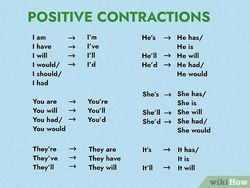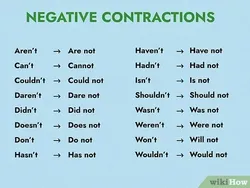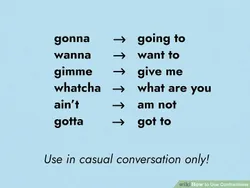Nov 3, 2022
Using contractions
1. Recognizing the purpose of contractions
Understand when it is appropriate to use a contraction. From a technical standpoint, contractions are not necessary in written English. The grammatically correct way to write requires the full version of every word. Contracting, or shortening words, should only be done for stylistic purposes and for specific types of writing.
If you are writing something where you are “talking” directly to your reader, you may use contractions. Writing a casual email or letter to a friend or someone you know well on a personal level would be an appropriate time to use contractions to keep your language from sounding stuffy or too formal. Contractions often create a friendly and casual tone when used in writing.
If you are writing dialogue in a play or a novel, you may use contractions to show how a certain character speaks to other characters. This also extends to school assignments when you are creating a scene for a play or writing a short story.
If you are creating a slogan or an advertisement, you may use contractions to keep the phrase short and to the point.
Avoid using contractions in formal documents like cover letters, medical documents, or legal documents. The only time you will use contractions in an academic essay is when you are quoting sources that use contractions. Some teachers and professors may be less rigid on the “no contractions” in an essay rule. Ask your teacher about this before you hand in an essay full of contractions.
2. Apostrophe
Use an apostrophe to make a contraction. When you create a contraction, you are taking two words and putting them together. You then insert an apostrophe to replace certain letters in the two words.[3]
For example: “he is” is contracted to: “he’s”. “They are” is contracted to: “they’re”.
You use contractions in a sentence to shorten the phrase and give it a less formal tone. For example: “They are playing together.” When you use a contraction, you combine “they” and “are”. You then replace the “a” with an apostrophe. The sentence becomes: “They’re playing together.”
You can also use contractions in questions. For example, “Where did they go?” When you use a contraction, you combine “where” and “did” together. You then replace the “i” with an apostrophe. “Where’d they go?”
3. Recognize the difference between “it’s” and “its”.
One of the most misused contractions is the contraction “it’s”. “It’s” is the contracted form of “it is” or “it has”. It is never the possessive form of “it”. Use the context of the sentence to determine if you need to use an apostrophe or no apostrophe for “it”.[4]
For example: “It’s late.” You use an apostrophe because this is the contracted form of “it is”. “It’s been a lovely evening”. This is the contracted form of “it has”.
But a sentence like: “The cat licked its tongue” does not require an apostrophe for “its” because the “its” is possessive in the sentence. “It” refers to “the cat” and is possessive, so it does not require an apostrophe. “The cat licked it’s tongue” would mean “The cat licked it is tongue” or “The cat licked it has tongue” and this is clearly incorrect.
1. Different kinds of contactions
Familiarize yourself with positive contractions. Positive contractions are used often in common speech and in casual writing. They are often used when a pronoun, such as “I” is next to a verb, such as “is”. The most common positive contractions include

Keep in mind the double meanings of some positive contractions. Some contractions, such as “he’d” could be the contracted form of either “he would” or “he had”. The context of the sentence will help you determine which meaning is implicated by the contraction. Always read the entire sentence to figure out what contraction is being used.
For example: “She’d like to go to the store.” This is the contraction of “She would like to go to the store” as it is the only grammatically correct option. “She had like to go to the store” is clearly incorrect.
“She’d completed the work by the time I arrived.” This is the contraction of “She had finished the work by the time I arrived” as it is the only grammatically correct option. “She would finished the work…” is clearly incorrect.
As well, the contraction “‘s”, the contracted form of “is” or “has” can be used with pronouns and it can be used with nouns, names, question words, and words like “here” and “there”. For example: “The plane’s late.” “Joan’s left.” “What’s the score?” “There’s the dog.” “Here’s your receipt.”
Identify negative contractions. Negative contractions are when you take a verb, such as “are” and combine it with “not”. The apostrophe is then used to replace the “o” in “not” so it becomes “n’t”. Examples of negative contractions are

Understand the double use of some negative contractions. When you are using the verb “to be” in a sentence and you are trying to create the negative form, there are two possible options. For example: “we are not” could be contracted to “we aren’t” or “we’re not”. “She is not” can be contracted to “she isn’t” or “she’s not”. “They are not” can be contracted to “they aren’t” or “they’re not”.
The exception is “I am not.” It can only be contracted to “I’m not”. Do not contract “I am not” to “I’m n’t” or “I am n’t”. In English, the contractions “‘s” and “‘re” usually appear after pronouns. For example: “We aren’t ready yet.” “He’s not a good man.”
You may put a contraction at the end of a question, such as: “You’ve spoken to Mark, haven’t you?” But if you are putting “am not” at the end of the question, it should be contracted to “aren’t”. For example: “I’m early, aren’t I?”
Apply only one contraction in a sentence. It is grammatically incorrect to put more than one contraction in a sentence that is not a question. For example: “He’s not here”, instead of “He’s n’t free”.[9]
Keep in mind positive contractions should appear in the middle or the beginning of the sentence, never at the end of a sentence. For example: “I think we’re lost.” “Yes, I think we are.” You would not write, “Yes, I think we’re”.
Use informal contractions in casual conversation only. Informal contractions like “gonna” (contracted form of “going to”), “wanna” (contracted form of “want to”) and “gimme” (contracted form of “give me”) are not appropriate for formal or informal writing, and should be restricted to casual conversation only. The exception is if you are writing dialogue in a novel, play, or other work of fiction where characters use informal contractions when they are speaking to each other. Informal contractions are not considered proper English and are often frowned upon even in casual speech.[10]
Other informal contractions include “whatcha” (contracted form of “what are you”), “ain’t” (contracted form of “am not”) and “gotta” (contracted form of “got to”).




By undefined
23 notes ・ 56 views
English
Intermediate